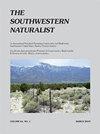十二穗波兰属亚种的果座、交配和雌雄同体。RIOGRANDENSIS (CLEOMACEAE)
IF 0.3
4区 环境科学与生态学
Q4 Agricultural and Biological Sciences
引用次数: 0
摘要
摘要雄激素分泌是一种个体既有双性恋又有雄花的性系统,在被子植物中作为一个整体很少见,但在锁骨科中相当常见。我们进行了温室实验,研究水果成熟和自我与交叉受精如何影响多德坎德拉(L.)DC的雄性花卉生产。亚种。里奥格兰登斯。当我们阻止果实成熟时,植物只产生两性花,但当我们允许果实成熟时,植物产生两性花和雄花的交替区域。这是P.Dodecandra亚种中雄激素单体症的首次文献。里奥格兰登斯。我们的结果支持男性专一的起源和维持的资源限制假设,但不支持替代的二歧化和建筑效果假设。多德坎德拉争议。Riograndensis有一个混合的配音系统。自我授粉并没有导致从双性恋到雄花的过渡较慢,但对于双性恋花的最初区域,自产水果的重量小于杂交水果。雌雄同体在北美神职人员中可能很普遍,我们敦促田间植物学家在观察和收集花卉时要注意花卉性。摘要雄激素雌雄同体是一种有性系统,在这种系统中,单个植物既有雌雄同体的花朵,在被子植物中作为一个整体并不常见,但在锁骨科中相当常见。我们在温室中进行了实验,研究果实成熟以及自我受精与交叉受精如何影响多德坎德拉(L.)DC.的雄花产量。亚种。里奥格兰登斯。当我们阻止果实成熟时,植物只产生两性花。但当我们允许果实成熟时,植物会产生雄性和双性花的交替区域。这是P.Dodecandra亚种中AndroMoneocia的第一份文献。里奥格兰登斯。我们的结果支持双性恋起源和维持中的资源限制假设,但不支持二分法和建筑效应的替代假设。多德坎德拉争议。Riograndensis有一个混合交配系统。自花授粉并没有导致两性花向雄性花的过渡较慢,但在两性花的最初区域,自花受精的果实比杂交的果实重。雄激素单体可能在北美的Cleomidos中广泛存在,我们敦促野外植物学家在观察和采集研究中考虑到花的性别。本文章由计算机程序翻译,如有差异,请以英文原文为准。
FRUIT SET, MATING, AND ANDROMONOECY IN POLANISIA DODECANDRA SUBSP. RIOGRANDENSIS (CLEOMACEAE)
Abstract Andromonoecy, a sexual system in which individuals have both bisexual and male flowers, is rare in angiosperms as a whole, but fairly common in Cleomaceae. We conducted greenhouse experiments on how fruit maturation and self- vs. cross-fertilization affect male flower production in Polanisia dodecandra (L.) DC. subsp. riograndensis. When we prevented fruit maturation, plants produced only bisexual flowers, but when we allowed fruit maturation, plants produced alternating zones of bisexual and male flowers. This is the first documentation of andromonoecy in P. dodecandra subsp. riograndensis. Our results support the resource limitation hypothesis for the origin and maintenance of andromonoecy, but not the alternative dichogamy and architectural effects hypotheses. Polanisia dodecandra subsp. riograndensis has a mixed mating system. Self-pollination did not result in slower transitions from bisexual to male flowers, but for the initial zone of bisexual flowers, selfed fruits weighed less than crossed fruits. Andromonoecy is likely widespread in North American cleomids, and we urge field botanists to be mindful of floral sex when observing and collecting. Resumen La andromonoecia, un sistema sexual en el que las plantas individuales tienen flores tanto bisexuales como masculinas, es poco común en las angiospermas como conjunto, pero bastante común en las Cleomaceae. Realizamos experimentos en invernadero investigando cómo la maduración de la fruta, y la auto-fertilización vs. la fertilización cruzada, afectan la producción de flores masculinas en Polanisia dodecandra (L.) DC. subsp. riograndensis. Cuando prevenimos la maduración de la fruta, las plantas produjeron solo flores bisexuales. Pero cuando permitimos la maduración de la fruta, las plantas produjeron zonas alternas de flores masculinas y bisexuales. Esta es la primera documentación de andromonoecia en P. dodecandra subsp. riograndensis. Nuestros resultados apoyan la hipótesis de limitación de recursos en el origen y mantenimiento de la andromonocia, pero no las hipótesis alternativas de dicogamia y efectos arquitectónicos. Polanisia dodecandra subsp. riograndensis tiene un sistema de apareamiento mixto. La autopolinización no resultó en transiciones más lentas de flores bisexuales a masculinas, pero en la zona inicial de flores bisexuales las frutas autofecundadas pesan menos que las cruzadas. Es probable que la andromonoecia esté muy extendida en los cleomidos de América del Norte, e instamos a los botánicos de campo a que tengan en cuenta el sexo floral durante sus estudios de observación y recolección.
求助全文
通过发布文献求助,成功后即可免费获取论文全文。
去求助
来源期刊

Southwestern Naturalist
环境科学-生态学
CiteScore
0.50
自引率
50.00%
发文量
47
审稿时长
18-36 weeks
期刊介绍:
The Southwestern Naturalist (a publication of the Southwestern Association of Naturalists since 1953) is an international journal (published quarterly) that reports original and significant research in any field of natural history. This journal promotes the study of plants and animals (living and fossil) in the multinational region that includes the southwestern United States, Mexico, and Central America. Appropriate submission of manuscripts may come from studies conducted in the countries of focus or in regions outside this area that report significant findings relating to biota occurring in the southwestern United States, Mexico, and Central America. Publication is in English, and manuscripts may be feature articles or notes. Feature articles communicate results of completed scientific investigations, while notes are reserved for short communications (e.g., behavioral observations, range extensions, and other important findings that do not in themselves constitute a comprehensive study). All manuscripts (feature articles and notes) require an abstract in both English and Spanish.
 求助内容:
求助内容: 应助结果提醒方式:
应助结果提醒方式:


